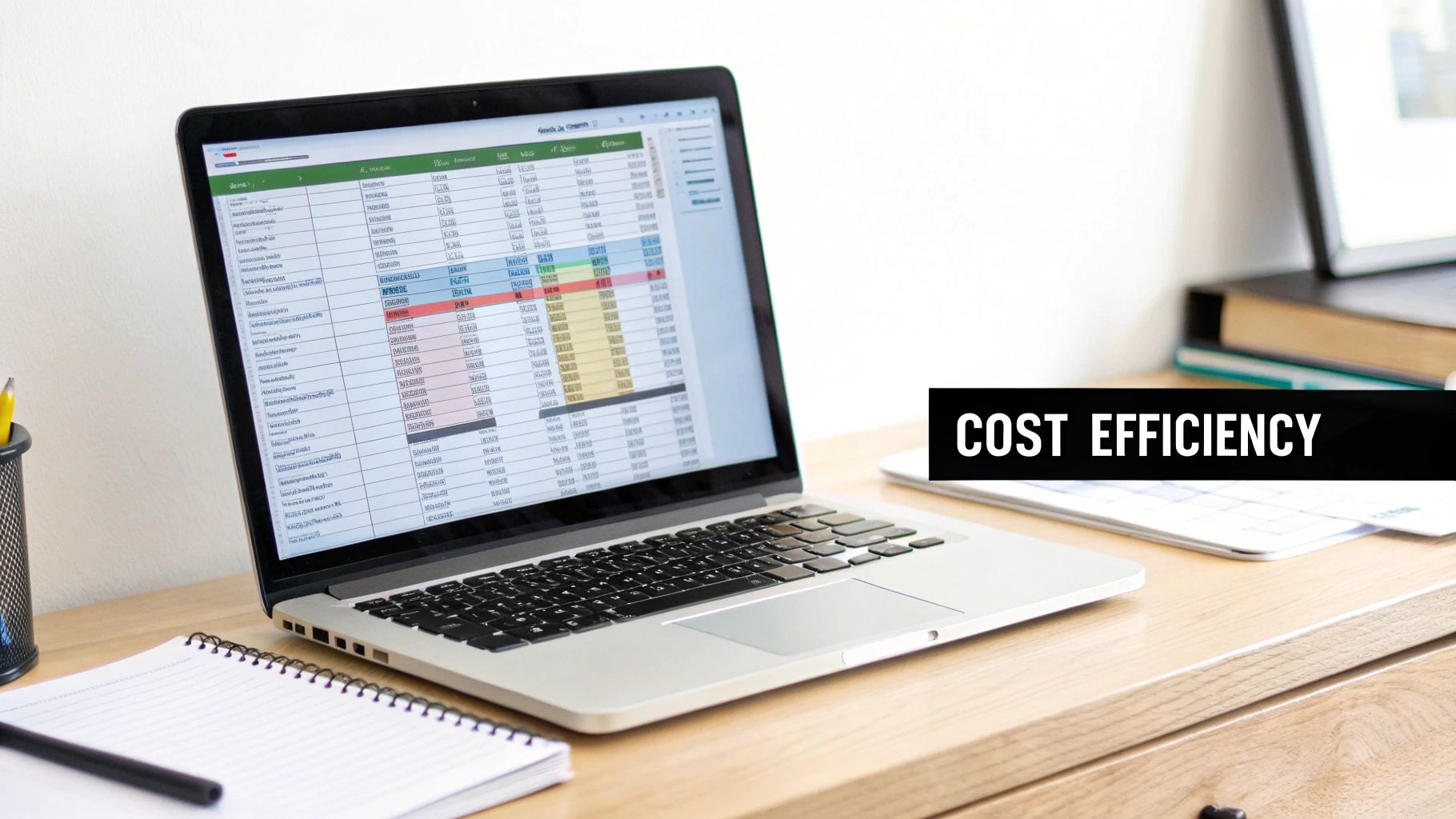Creating Your Financial Foundation

A startup budget template is like a GPS for your business finances – it guides your decisions and helps you stay on track toward your goals. Just as every journey is unique, your budget template needs to reflect your specific business model and objectives. Simply downloading a generic template won't cut it – you need to craft one that truly fits your needs.
Essential Components of a Startup Budget Template
A great budget template goes beyond basic income and expense tracking. Think of it as your financial dashboard, giving you real-time insights into your business health and helping you spot opportunities and challenges ahead. Here are the key elements to include:
- One-Time Costs: These are your initial investments to get started – things like equipment purchases, inventory setup, and website development. Getting these numbers right is crucial since they represent your biggest upfront spending.
- Recurring Expenses: Picture these as your monthly commitments – rent payments, team salaries, marketing costs, and software subscriptions. Understanding these regular costs helps you manage your cash burn and maintain healthy margins.
- Revenue Streams: Map out exactly how money flows into your business. Break down your pricing strategy, expected sales volume, and any subscription or recurring income. This section becomes your North Star for tracking growth.
By organizing your finances into these clear categories, you gain deep insights into your spending patterns and can make smarter forecasts about your future needs.
Building a Template That Works for You
Creating an effective budget template is a personal process. While you can find plenty of templates online, the key is adapting one to match your specific situation. Consider your industry, growth stage, and how you fund your business.
For instance, a software company running on subscriptions needs very different metrics than an e-commerce store selling products. The software company might focus heavily on customer retention and lifetime value, while the store needs to track inventory costs and marketing returns closely.
Using Your Template for Strategic Decision-Making
Your budget template becomes a powerful ally in making smart business moves. Here's how it helps:
- Forecast Cash Flow: By mapping out future income and expenses, you can spot potential cash crunches early and plan accordingly – whether that means raising funds or trimming costs to extend your runway.
- Monitor Performance: Regular budget reviews help you catch problems quickly. If spending exceeds targets or revenue falls short, you can adjust course before small issues become big headaches.
- Secure Funding: A detailed budget shows potential investors you're serious about financial management. It demonstrates you understand your numbers and can be trusted to use capital wisely.
When you actively use your budget template, you shift from reacting to financial surprises to planning ahead with confidence. This data-driven approach helps you build sustainable growth while avoiding common startup pitfalls. Your budget becomes more than just numbers – it's a roadmap guiding you toward long-term success.
Mastering Revenue Projections That Work

Every strong startup budget template needs realistic revenue projections at its core. These numbers aren't just abstract figures – they represent your company's potential growth and financial future. Getting them right means carefully translating your vision into concrete targets that can guide your business forward. Let's explore how to create revenue projections that strike the right balance between ambition and reality.
Balancing Optimism and Reality in Your Startup Budget Template
Many founders struggle to find the sweet spot between projecting exciting growth that attracts investors and staying grounded in market realities. It's tempting to forecast dramatic early-stage revenue, but this can lead to poor resource management that puts the whole business at risk. For example, while projecting 3x growth in year one might look great on paper, working backwards through your startup budget template often reveals whether that target truly makes sense given your specific market conditions, product readiness, and team capabilities. Taking this methodical approach helps align enthusiasm with real-world constraints.
Identifying Key Revenue Drivers Within Your Projections
Understanding your key revenue drivers is essential – these are the specific factors that directly impact your ability to generate income. For SaaS companies, crucial metrics often include customer lifetime value and churn rate. E-commerce businesses typically focus on average order value and conversion rates. By identifying these core drivers in your startup budget template, you can concentrate your efforts on the activities that move the needle most. This targeted approach leads to more accurate projections and better growth strategies.
Building Adaptable Models in Your Startup Budget Template
Markets constantly shift and change. Economic conditions fluctuate, consumer behaviors evolve, and new challenges emerge. That's why your startup budget template must be flexible enough to adapt. Build models that can adjust based on real performance data and market feedback. Include different scenarios – optimistic, moderate, and conservative projections – to prepare for various possibilities. This helps you make informed decisions even when facing unexpected hurdles.
Your startup budget template works best as a living document that grows with your business. Rather than creating static projections, develop a framework that lets you respond proactively to change. Regular reviews of actual results against projections help you refine your assumptions and keep your financial planning on track. With careful attention to both ambitious targets and practical constraints, your startup budget template becomes a powerful tool for steering your company toward sustainable success through smart, responsive financial planning.
Smart Cost Management for Modern Startups

Every dollar counts when building a startup. While tracking revenue is essential, mastering cost management can make the difference between success and running out of runway. A startup budget template helps you gain visibility into spending and make informed decisions about where to invest your limited resources. For instance, small recurring expenses that seem minor can add up significantly over time, impacting your cash flow. Let's explore practical ways to manage costs effectively using your budget template as a guide.
Categorizing and Tracking Costs Within Your Startup Budget Template
Clear cost categorization gives you a detailed view of your spending and helps identify areas for optimization. Two main types of costs need careful tracking:
- Fixed Costs: These predictable monthly expenses stay constant regardless of sales volume – think office rent, employee salaries, insurance premiums, and software subscriptions. Tracking fixed costs helps determine your break-even point and minimum operating expenses.
- Variable Costs: These expenses change based on business activity, including raw materials, production costs, sales commissions, and marketing spend. For example, doubling your ad budget might boost sales – but only if the return justifies the increased cost.
By monitoring both fixed and variable costs in detail, you gain valuable insights into spending patterns and can spot opportunities to reduce waste while maintaining quality. This data-driven approach enables smarter financial choices.
Strategic Resource Allocation Using Your Startup Budget Template
Beyond tracking expenses, your budget template helps you invest strategically based on business priorities and expected returns. A software company might put more resources into customer support versus fancy offices to boost retention and lifetime value. A hardware startup could prioritize R&D spending to speed up product development. The budget template provides a framework to evaluate these trade-offs and ensure your spending aligns with key goals.
Vendor Negotiation and Cost Savings with a Startup Budget Template
Your budget template becomes a powerful tool during vendor discussions. Understanding your exact costs helps you negotiate better deals and more favorable terms. You can often secure volume discounts by showing vendors your growth projections. The template also lets you compare different vendors on overall value – not just price – so you choose partners who deliver quality cost-effectively. Taking an active approach to vendor management through data-driven negotiations can significantly reduce expenses and help your startup's funds last longer. When you optimize costs strategically while maintaining high standards, you create a strong foundation for sustainable growth.
Building Better Cash Flow Systems

Getting your costs and revenue projections right sets the stage for financial success. But to really understand how these elements affect your daily operations, you need a well-designed cash flow system. Your startup budget template becomes an essential tool for looking ahead and managing your cash position – giving you the resources to jump on opportunities and handle any bumps in the road. When you have a clear system in place, backed by detailed budgeting, you can make confident financial decisions that push your business forward.
Forecasting Cash Flow With Your Startup Budget Template
Like a captain needs navigation tools, your startup needs clear cash flow forecasts. Start by mapping out expected money coming in and going out – typically month-by-month for year one, then quarterly after that. This detailed view helps you keep close watch during those critical early days. Your startup budget template provides the framework – plug in projected sales alongside regular costs like payroll and rent to calculate your net cash flow each period. This helps paint a clear picture of where your cash position will be over time, showing you potential tight spots or surplus periods ahead.
Identifying Potential Cash Crunches With Your Projections
By looking closely at your cash flow projections in your startup budget template, you can spot potential cash shortages before they become problems. It's like checking the weather forecast – you get advance warning to prepare. For example, your numbers might show a big cash drain three months out due to an upcoming marketing push. With this early heads up, you have time to explore options like adjusting campaign timing, securing short-term financing, or working out extended payment terms with vendors. Being proactive helps you avoid sudden cash crunches that could derail your progress.
Developing Contingency Plans for Cash Flow Challenges
Having backup plans ready is key to building a strong cash flow system. This means creating specific action plans for different scenarios, like slower sales or surprise expenses. Let your startup budget template guide these plans. For instance, if sales drop 20% below target, your contingency might include cutting optional spending by 15% while exploring new revenue streams. With clear plans already mapped out, you can act quickly and decisively when challenges arise, keeping disruptions to a minimum.
Maintaining Healthy Cash Reserves for Growth and Stability
While watching expenses is crucial, keeping strong cash reserves is just as important. Your startup budget template should include target cash levels to cushion against surprises and fund future growth. Think of these reserves as your financial safety net, helping you weather unexpected storms without derailing long-term goals. Plus, having cash on hand lets you act fast on opportunities that require upfront investment, like expanding to new markets or developing new products. This forward-thinking approach to cash management, guided by solid budgeting, positions your startup not just to survive but to flourish.
Smart Tools for Financial Success
A strong startup budget template is only the beginning. The real power comes from pairing your budget with the right digital tools. Forward-thinking startups are moving beyond basic spreadsheets, using smart software to transform their financial management. This shift means less time on data entry and more time making bold moves that drive growth.
Putting Your Budget on Autopilot
Make your startup budget template work smarter by connecting it to your accounting systems. When you sync with platforms like Xero or QuickBooks Online, transactions flow directly into your budget template without manual entry. This does more than just save time – it gives you accurate, up-to-the-minute insights for better decisions. You can also generate key reports in seconds rather than hours of manual work.
Taking Budgeting to the Cloud
While spreadsheet connections are useful, dedicated cloud budgeting platforms open up exciting new possibilities. These tools let you play out "what-if" scenarios to see how different choices could impact your bottom line. For instance, you can quickly model the financial effects of growing your team or launching a new campaign before committing resources. Cloud platforms also make it simple for founders, finance teams, and advisors to collaborate smoothly on budgets and stay aligned on goals.
Finding Your Perfect Financial Toolkit
The right tools depend on your startup's unique situation. Early-stage companies with basic needs might do well with a spreadsheet template linked to accounting software. But as you scale and add complexity, purpose-built budgeting platforms become increasingly valuable. A high-growth startup juggling multiple departments and revenue streams, for example, may find advanced forecasting features essential for maintaining clarity. The key is choosing tools that help you extract meaningful insights from your budget data to fuel smart, sustainable growth decisions.
Maintaining Financial Clarity as You Scale
Building and growing your startup brings exciting momentum, but it also demands attention to financial details as operations get more complex. What worked for managing finances in your earliest days needs thoughtful updates to stay effective during rapid growth. Just like navigating a long journey requires periodic course corrections, your startup budget needs regular review and refinement. Let's explore practical ways to maintain clear financial visibility while scaling your business.
Conducting Effective Budget Reviews
Think of your budget like your car's dashboard – you need to check those gauges regularly to stay on track. Set up monthly budget reviews at minimum, and increase the frequency during high-growth periods. But don't just look at numbers in isolation. Involve key team members in budget discussions to tap their on-the-ground insights. For example, your marketing team can share campaign performance data that helps refine revenue projections. This collaborative approach ensures everyone understands the financial picture and can contribute to smart decisions.
Adjusting Projections Based on Real Performance Data
Your budget shouldn't exist separately from reality. Make it a practice to compare actual results against your projections through variance analysis. When sales consistently beat forecasts, that's a signal to revisit your revenue model and potentially adjust how you allocate resources. If costs regularly exceed estimates, investigate why and take corrective action. Let real data guide you in fine-tuning your budget to better reflect your business's true financial patterns.
Maintaining Financial Discipline During Rapid Growth
Growth phases often bring exciting opportunities – and the temptation to overspend. Your budget serves as a vital tool for maintaining financial discipline during expansion. Set clear spending guidelines for each department and track expenses carefully to prevent runaway costs. If teams consistently exceed their allocated budgets, work together to understand the root causes and find solutions. Building this culture of financial accountability across your organization helps ensure sustainable growth.
Frameworks for Variance Analysis, Performance Tracking, and Budget Revisions
Add structure to your financial oversight with clear frameworks. Define thresholds for what counts as a significant budget variance requiring immediate action. Track key performance indicators (KPIs) that connect directly to your business goals and integrate them into your budget monitoring. Create a formal process for budget revisions that involves key stakeholders and documents all changes. This structured approach maintains transparency as your company grows.
By committing to regular reviews, incorporating real performance data, and upholding financial discipline, your budget becomes a powerful tool for managing growth effectively. This proactive financial management helps you make informed decisions, optimize your resources, and build lasting success. It also demonstrates financial responsibility to investors and stakeholders, building their confidence in your leadership.
Ready to transform your vision into a thriving reality? MarkBox Studios specializes in helping founders and business owners like you achieve sustainable growth through expert MVP development and scalable solutions. We empower you to navigate the challenges of building a successful business, from providing weekly startup insights to offering personalized consultations. Visit us at https://www.markboxstudios.com to explore how we can help you reach your goals.



